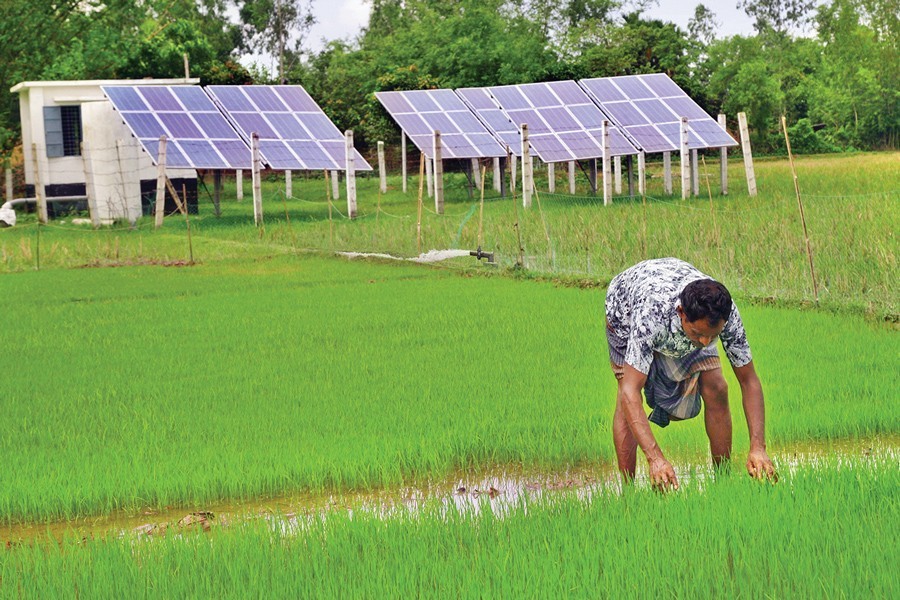A major problem farmers all over the country find critically linked to cultivation, also to their misery, is the scarcity of power or the high cost of oil-propelled power for irrigation. The situation has improved to some extent recently, and chances are that it would improve noticeably in the near future with increased use of solar power look quite prospective.
Use of solar power for irrigation can be a real game changer, opine experts. Absence of a viable alternative to diesel to reduce the cost of irrigation in the country has seen unaffordable rise in the cost of cultivation. Solar-powered irrigation is a reliable alternative for farmers as it helps reduce costs, protect the environment, and lower import of expensive diesel fuel.
Concerned quarters, including farmers, are finding it increasingly difficult to rely either on diesel or grid electricity as a secure and affordable means of providing the much needed water for irrigation, particularly in the dry season. While grid electricity has so far remained largely uncertain and out of reach in many parts of the country, the price of diesel makes cultivation highly costly.
The government has signed a $10 million grant agreement with the World Bank, as part of a total commitment of $24.5 million, to introduce solar irrigation pumps for farmers. A project under the multi-donor financing is in place to enable installation of more than 1,300 solar-powered irrigation pumps covering more than 65,000 bighas of land for paddy cultivation. Aimed at providing farmers with clean energy at considerably lower costs compared to diesel, this project is designed to replace diesel pumps with solar irrigation pumps in areas where grid electricity has not reached. It has been learnt that thirteen hundred solar irrigation pumps to be installed in phases under the project would save the country $3.2 millions in foreign currency annually due to replacement of diesel. Needless to say, large-scale use of solar-powered irrigation pumps will substantially reduce the country's diesel imports. Bangladesh currently spends $900 million per year on diesel to power its irrigation systems. Besides, as a result of the use of clean and renewable energy, carbon emission is expected to be reduced by 10,000 tonnes every year. Private sponsors will be responsible for installing, operating and maintaining the solar pumps, while donor financing will provide up to 30 per cent in concessional credit. Private sponsors are expected to provide 20 per cent of the pump costs as equity.
Solar energy, believed to be one of the most secure and low cost source of electricity, has begun to be used in the country's rural households in recent times thanks mainly to the efforts of non-government organisations (NGOs). In a country like Bangladesh with abundant sunshine for most of the year, sourcing energy from the sun rays should be a fittingly gainful experience for irrigation. Since the need for water is the highest on hot sunny days, the technology is an obvious choice.
Solar-powered pumps are extensively used in the African continent. Once a very expensive technology, prices have reportedly dropped in recent years because of extensive use and rebates provided by governments. Solar irrigation system is extensively used to pump water from wells or rivers for irrigation and domestic consumption. In the Indian states of Gujrat and Karnataka, solar pumps are mainly responsible for revolutionising cultivation because of uninterrupted supply of water for irrigation at affordable costs. The typical solar-powered pumping system consists of an array of solar panels. These solar panels power an electric motor which provides power to the surface and bore pumps. The water is pumped from the ground or a nearby stream into a storage tank, which provides a gravity feed.
Since water is mostly required on hot and sunny days, solar irrigation technology makes sense and is an obvious choice for irrigation. Pumping water using the PV technology, according to experts, is reliable, simple and requires minimum maintenance. PV pumping systems comprise a PV array, a bore pump and a motor. Solar water pumping arrays are fixed or mounted, or sometimes they are placed on passive trackers. This is done to increase the pumping volume and save time. AC and DC motors with displacement or centrifugal pumps are used for the same purpose. In farmlands where a creek runs through the property, using solar-powered water pumping solution means less tampering with the waterways and also less erosion of the water banks. This can also lead to better pasture management as livestock can access water via multiple water distribution points.
In Bangladesh, installation of solar pumps at the initial stage may be costly but according to experts, extensive use will cut cost to a level far below the diesel cost. There is thus the need to popularise the technology as well as attract investment in research and innovation to bring down the cost.


